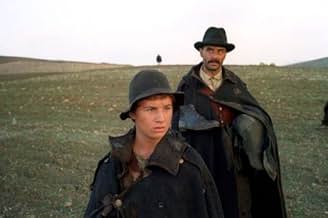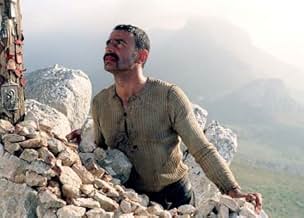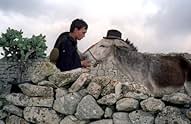Un paysan sicilien entreprend le voyage vers la terre promise et rencontre une belle Anglaise. Aucun des deux n'est préparé aux dures réalités d'Ellis Island. Arriveront-ils à franchir la po... Tout lireUn paysan sicilien entreprend le voyage vers la terre promise et rencontre une belle Anglaise. Aucun des deux n'est préparé aux dures réalités d'Ellis Island. Arriveront-ils à franchir la porte dorée qui mène à l'Amérique de leurs rêves ?Un paysan sicilien entreprend le voyage vers la terre promise et rencontre une belle Anglaise. Aucun des deux n'est préparé aux dures réalités d'Ellis Island. Arriveront-ils à franchir la porte dorée qui mène à l'Amérique de leurs rêves ?
- Réalisation
- Scénario
- Casting principal
- Récompenses
- 22 victoires et 29 nominations au total
- Il Gatto
- (as Paride Benassai)
- Dottore
- (as Giuseppe Cutino)
- Mangiapane
- (as Massimo La Guardia)
Avis à la une
The film opens in turn of the century Sicily as poverty stricken widower Salvatore Mancuso (Vincenzo Amato) and his brother Angelo (Francesco Casisa) climb a rocky hill to present their tokens to the cross to ask for a sign as to whether they should continue to struggle for existence on the island or go to America, the land of dreams. Mancuso's deaf mute son Pietro (Filippo Pucillo) runs to the top of the hill with postcards he has found with images of America (money growing on trees, fruits and vegetables larger than people, etc), and Salvatore accepts this as the sign that he should move his family to America. After convincing his reluctant mother Fortunata (Aurora Quattrocchi) and his sisters Rita (Federica De Cola) and Rosa (Isabella Ragonese) to make the trip, he sells his only possessions (two donkeys, goats, and rabbits) and the man with the boat arranges their trip, giving the family shoes, appropriate clothing, and instructions to board an ocean liner as third class passengers. As the Mancuso family prepares to board they are asked for a photograph, and as they pose behind a painted set, an Englishwoman Lucy/Luce (Charlotte Gainsbourg) walks into the photo as though she were part of this peasant family. Lucy cannot board the boat for America without male escort.
The voyage begins and Luce in her gentle way identifies with the Mancuso family, finally solidifying her safe passage by proposing to Salvatore to marry her 'for convenience, not for love' when they arrive in America. Through a violent storm and living conditions that are appalling poor, the multitude of third class passengers survive, bond, and eventually arrive at Ellis Island, believing their dream of America has been fulfilled. But everyone must pass harsh physical tests, de-lousing, and even intelligence testing to determine if they can enter America: the officials let them know that America does not want genetically inferior people entering the new world! Each woman must be selected by a man to marry on Ellis Island before they are allowed admission. The manner in which the Mancuso family remains united until a somewhat surprising ending is the closing of the tale.
Few of us understand the strict rules and harsh treatment immigrants face (or at least faced at the turn of the century) on Ellis Island, and if we do we have elected to submerge that information. THE GOLDEN DOOR presents the case for immigrants' struggles in a manner that not only touches our hearts but also challenges our acceptance of current immigration legislation. But all political issues aside, THE GOLDEN DOOR is first and foremost a film of enormous beauty, exquisite photography, deeply felt performances by a huge cast, and a very sensitively written and directed story. The is a film that deserves wide distribution, a movie that is a must see for everyone. Highly recommended. Grady Harp
Saw this movie last year and found it inspiring that hopeful immigrants, like my Italian grandparents who came through Ellis Island at the turn of the last century, would subject themselves to all manner of invasive inspection just to enter America.
It was certainly eye opening, since my grandparents never spoke of anything terrible while there. My grandmother was 5-years old and my grandfather 18 when they arrived.
I just returned from a trip to New York where I had the pleasure of visiting Ellis Island and the museum actually walks you through the immigration evaluation process - The filmmaker obviously did his research, right down to the medical exams and equipment, questions and puzzles. They are all there at the museum. Even the wedding pictures and the review board room -- Factually correct! Anyone who has immigrant grandparents should see this movie. Inspirational to say the least.
I got drawn to this movie because it tells of immigrants from Sicily who traveled to America. I imagine much the same as my Grandfather did at that time. Travelling in steerage to provide ballast for the ships, I cannot imagine it was very comfortable, as shown in this film.
Laws restricting immigrants existed. I would guess that these laws were more strict on those who came from the Mediterranean and Africa. Immigrants had to be free from contagious diseases or hereditary infirmities. In the film, we see physical and mental exams, the latter because of the view that low intelligence is heritable. Single women could not enter the country, on the presumption that they would become prostitutes, so most married single men already in the country, as arranged beforehand, at Ellis Island before entry.
This is the story of a British immigrant (Charlotte Gainsbourg), who arranges to marry a poor Sicilian (Vincenzo Amato). He is trying to get his family through with a son that is mute and a mother (Aurora Quattrocchi) that is considered feeble-minded. She was fantastic in the role, by the way.
You will also see character actor, Vincent Schiavelli, in his next to the last appearance. I don't know if his last film has been released. He plays a matchmaker, and is also very good.
It was a strange, but enjoyable film. It's not for everyone, as I imagine those who don't have some interest in the immigrant experience would find it rather slow.
3 / 5
The only relief from the boredom (like the voyage) is the occasional Fellini-like impressionism: One prominently has characters swimming in milk (as in the "land of milk and honey") more than once. It could be argued that the director doesn't prepare the audience for the abrupt transitions into the formalist episodes, but I felt relief with them.
By contrast Mira Nair's recent Namesake is superior in telling an interesting story about identity and the new world, and Chaplin's Immigrant (1917) makes the boat ride a model of slapstick and the restaurant scene not only humorous but telling about the challenges immigrants inevitably face. Nobody ever said Chaplin was boring.
Charlotte Gainsbourg stands out as Lucy, a husband-seeking Brit whose literate background makes her useful, and whose role as a strong, beautiful woman allows the film to explore the prejudices against women. She is unforgettable when she and other women sit in a room awaiting the magistrate's permission to marry a man often the woman is meeting for the first time. That a woman would need a man to qualify for entry into America may not be so anachronistic given Hilary needing Bill to make her political career in the twenty first century.
Agnes Godard's cinematography is often the salvation of a scene, for instance when she catches two mountain climbers with rocks in their mouths deftly negotiating a rock-strewn hill top to arrive at a shrine. Mostly she photographs the climbers close up to keep the adventurous sense of surprise. Then she reduces them to just more rubble as she pulls back into a major bird's eye view losing them slowly just as their journey across the Atlantic will reduce them again.
It's a slow journey.
Le saviez-vous
- AnecdotesDirector Emanuele Crialese personally chose every one of the 700 extras who appeared in the film. He said he was looking for people who could evoke the same facial expressions of the actual immigrants whose photographs Crialese came across when he was researching the film.
- Citations
Lucy Reed: Madam? Madam. Could you lower your voice? I have a headache.
Fortunata Mancuso: Then have one! What do I care? Who does she think she is? This is the last thing I need. A journey like this ahead and she has a headache.
- Bandes originalesFeeling good
Words and Music by Leslie Bricusse and Anthony Newley, Adapted and Performed by Nina Simone
Meilleurs choix
- How long is Golden Door?Alimenté par Alexa
Détails
- Date de sortie
- Pays d’origine
- Sites officiels
- Langues
- Aussi connu sous le nom de
- 燦爛新人生
- Lieux de tournage
- Sociétés de production
- Voir plus de crédits d'entreprise sur IMDbPro
Box-office
- Budget
- 10 000 000 € (estimé)
- Montant brut aux États-Unis et au Canada
- 1 070 769 $US
- Week-end de sortie aux États-Unis et au Canada
- 27 744 $US
- 27 mai 2007
- Montant brut mondial
- 7 228 273 $US
- Durée
- 1h 58min(118 min)
- Couleur
- Mixage
- Rapport de forme
- 2.35 : 1

















